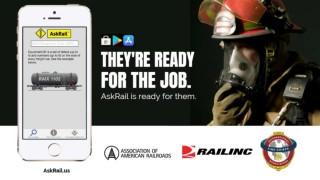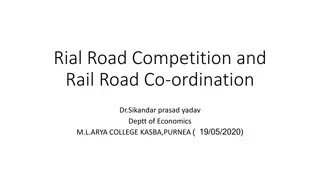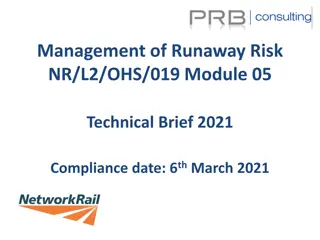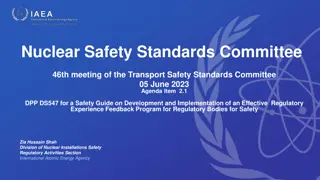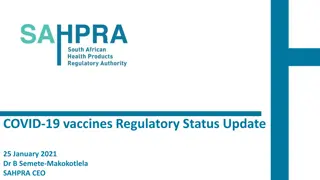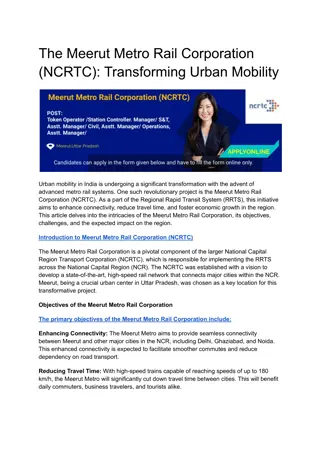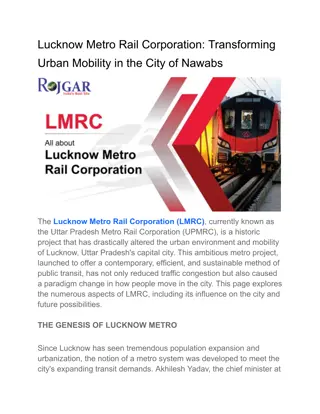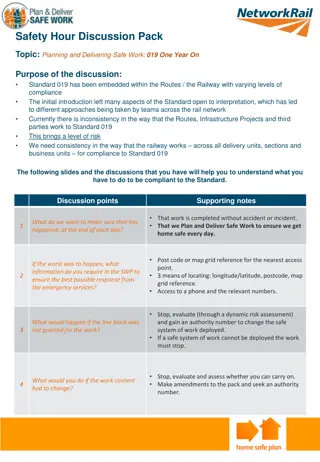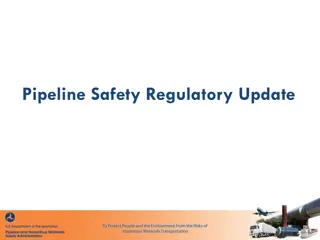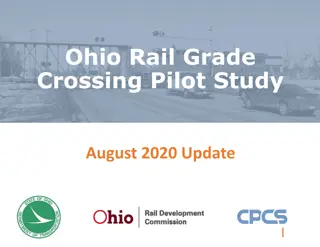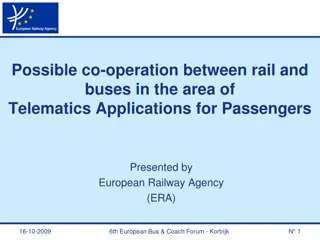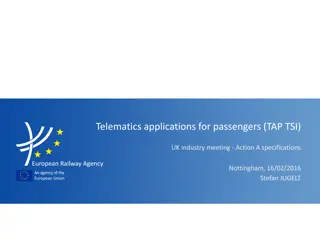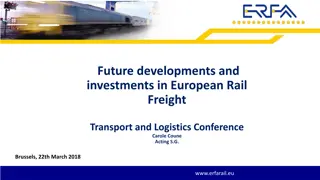Rail Safety Update: Annual Report Highlights and Regulatory Responsibilities
The Office of Rail and Road in Great Britain serves as an independent regulator focusing on the safety and economic aspects of railways. The annual health and safety report underscores the continued safety of Britain's mainline railways while highlighting challenges such as serious accidents, post-pandemic behavioral changes, and resilience to extreme weather events. With a focus on legal compliance, risk management, and excellence in business management, the regulator plays a crucial role in ensuring the safety of railways across the country.
Download Presentation

Please find below an Image/Link to download the presentation.
The content on the website is provided AS IS for your information and personal use only. It may not be sold, licensed, or shared on other websites without obtaining consent from the author. Download presentation by click this link. If you encounter any issues during the download, it is possible that the publisher has removed the file from their server.
E N D
Presentation Transcript
RMT RMT C Conference onference Update on Rail Safety Update on Rail Safety Ian Prosser CBE HM Chief Inspector of Railways 22/02/2023 Ian Prosser CBE HM Chief Inspector of Railways 22/02/2023
Office of Rail and Road Office of Rail and Road We are the independent Health & Safety and economic regulator of railways in Great Britain. Our economic regulator work focuses on the mainline railway but our safety responsibilities cover all railways in GB. Economic Role was set up in 1994; our role derives from UK and EU legislation; Independent of ministerial control; public interest objectives are set by Act of Parliament; and Economic regulation role similar to other UK utilities and thus well understood. Safety regulation of railways transferred from the Health and Safety Executive to ORR in 2006 but has over 180 year history. Monitor the strategic road network orr.gov.uk orr.gov.uk 2 2
W Wh ho o a ar re e w we e? ? ~ ~ 3 30 00 0 s st ta af ff f Railway Health and Safety Regulation approx. 120 staff Engineering & Asset Management approx. 35 staff G Ge en ne eral C Co ou uns Co Le ral nse el l, , pet titi gal l S Se erv Com Lega mpe itio on n & & rvic ices es Rai ilw P Pl la anni P Pe er rf for H Hi ig gh hw wa ays Ra lwa ay y nnin ng, orm g, R Rail ailway way Sa Saf fe et ty y manc ance e & & ys Six offices across the Great Britain E Ec co on no omics M Mark Str mics Co Comm mmu un nicatio ications ns arke ets ts & & Strat ate egy gy Cor rpo Op O Org D Dev Co por ra ate te ns & & tion pme en nt t Ope er ra at tio ions rga an nis isa ation eve el lo opm o orr. rr.g go ov. v.u uk k 3 3
Our role as Health and Safety Regulator Our role as Health and Safety Regulator Checking legal compliance - control of risks - every day - by businesses. Pushing for excellence in management by businesses - because excellent management means - more likelihood of compliance every day. - more likelihood of control of risks every day. orr.gov.uk orr.gov.uk 4 4
Annual Health and Safety Report headlines Annual Health and Safety Report headlines Britain s mainline railways remain one of the safest in Europe However: Serious accidents and near misses Post pandemic and changes in public behaviour Enormous change and challenge Resilience to extreme weather events orr.gov.uk orr.gov.uk 5 5
Working with industry to improve health and safety Working with industry to improve health and safety Earthworks and drainage management (predates Carmont) Track worker safety Network Rail, 98% reduction in lookout working (MAA) of track work related near- misses fell by 70% Management of rolling stock (2 yr programme) Hitachi cracking, safety validation and assurance through supply chain (freight and ECMs), software and change Stations and platforms warnings, barriers, accessibility and risk management tools SPADs, driver managers and investigations Ensuring change is managed safely TfL and light rail. orr.gov.uk orr.gov.uk 6 6
The challenges ahead The challenges ahead 1. Managing the legacy impacts of the pandemic 2. Managing change: safety by design and successful, safe transition 3. Supporting people 4. Implementing technologies effectively orr.gov.uk orr.gov.uk 7 7
Managing the legacy impacts of the pandemic Recover where activity has been at reduced levels during the pandemic e.g training, assessment and management assurance. We need to recover these situations as quickly as possible. It is essential to improve connections between the top and bottom of dutyholders organisations. Managing the industry s financial situation following the pandemic. Positive outcomes need to continue e.g. less overcrowding, cleaner trains/stations. Managing the legacy impacts of the pandemic orr.gov.uk orr.gov.uk 8 8
Managing change: Successful, safe transition Managing change: Successful, safe transition We must not lose focus on the day job and management at all levels, particularly in frontline assurance. Manage the organisational changes effectively, not always having been achieved in the past. Change should involve those most affected by the change, a challenge in a climate of difficult industrial relations. Changes must be taken through appropriate safety validation including the creation of Great British Railways (GBR). orr.gov.uk orr.gov.uk 9 9
Supporting people Some good progress has been made on health and wellbeing. However it will be a challenge to keep up the momentum and accelerate advancement as we continue to need to look after each other and our mental health and wellbeing. We will continue to support and encourage the mainline industry to develop shared collection and analysis of data on health a foundation of better health management. Improving occupational health provision e.g. we will be monitoring Network Rail s delivery of state of the art clinics, which will enable to offer significantly improved occupational health management for the whole mainline sector. Improve fatigue management. Supporting people orr.gov.uk orr.gov.uk 10 10
Implementing technology effectively The Network Rail Weather Risk Task Force on earthworks and weather management is a good example of how technology could lead to a step change, not just in risk reduction but passenger experience and efficiency. Technology can improve efficiency in many forms of inspection and in train operations. Adopting value for money signalling solutions that can also be deployed to protect engineering possessions, enforce speed restrictions and warn level crossing users of approaching trains. Making the best use of technological development in weather prediction. For example, we will be maintaining close scrutiny of Network Rail s plans to embrace technology that can bring more targeted, effective management of the effects of extreme whether. Making use of technology to improve passenger safety at platform-train interface. Developing alternative traction technologies for example, battery and hydrogen operated trains. Implementing technology effectively orr.gov.uk orr.gov.uk 11 11
Q&As Q&As


